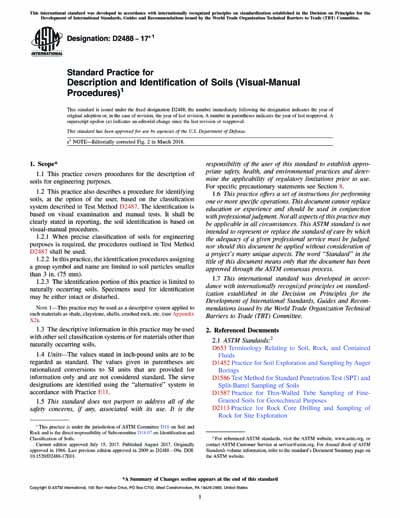Most recent
ASTM D2488-17e1
Standard Practice for Description and Identification of Soils (Visual-Manual Procedures)
1.1 This practice covers procedures for the description of soils for engineering purposes.
1.2 This practice also describes a procedure for identifying soils, at the option of the user, based on the classification system described in Test Method D2487. The identification is based on visual examination and manual tests. It shall be clearly stated in reporting, the soil identification is based on visual-manual procedures.
1.2.1 When precise classification of soils for engineering purposes is required, the procedures outlined in Test Method D2487 shall be used.
1.2.2 In this practice, the identification procedures assigning a group symbol and name are limited to soil particles smaller than 3 in. (75 mm).
1.2.3 The identification portion of this practice is limited to naturally occurring soils. Specimens used for identification may be either intact or disturbed.
Note 1: This practice may be used as a descriptive system applied to such materials as shale, claystone, shells, crushed rock, etc. (see Appendix X2).
1.3 The descriptive information in this practice may be used with other soil classification systems or for materials other than naturally occurring soils.
1.4 Units—The values stated in inch-pound units are to be regarded as standard. The values given in parentheses are rationalized conversions to SI units that are provided for information only and are not considered standard. The sieve designations are identified using the “alternative” system in accordance with Practice E11.
1.5 This standard does not purport to address all of the safety concerns, if any, associated with its use. It is the responsibility of the user of this standard to establish appropriate safety, health, and environmental practices and determine the applicability of regulatory limitations prior to use. For specific precautionary statements see Section 8.
1.6 This practice offers a set of instructions for performing one or more specific operations. This document cannot replace education or experience and should be used in conjunction with professional judgment. Not all aspects of this practice may be applicable in all circumstances. This ASTM standard is not intended to represent or replace the standard of care by which the adequacy of a given professional service must be judged, nor should this document be applied without consideration of a project's many unique aspects. The word “Standard” in the title of this document means only that the document has been approved through the ASTM consensus process.
1.7 This international standard was developed in accordance with internationally recognized principles on standardization established in the Decision on Principles for the Development of International Standards, Guides and Recommendations issued by the World Trade Organization Technical Barriers to Trade (TBT) Committee.
ASTM International [astm]

